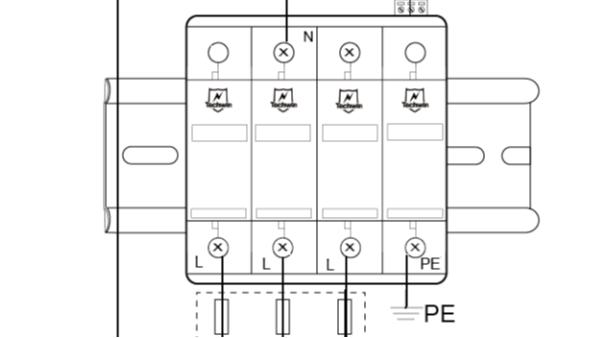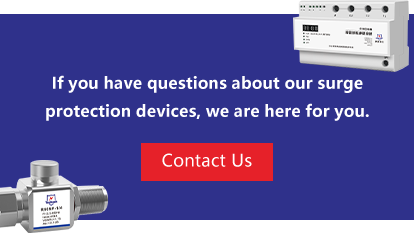In the TN system, in general, the surge protector only needs to be connected in common mode, that is, connected between the neutral line of the phase line and the protective ground line. However, in the starting position of the TN-S system, there is no need to connect a surge protector between the neutral wire and the protective ground wire. Only for the power ports of the particularly important equipment on the third and fourth levels in the A-level lightning protection level and the third level in the B-level lightning protection level, differential mode access is required, that is, the connection between the phase line and the neutral surge protector between wires.
In the TT system, when the first-level surge protector is located behind the leakage protector, the above common mode connection method can be used. When the first-level surge protector is located in front of the leakage protector, and the high-voltage system is the center point grounding system, the surge protector should be connected to "3+1", that is, the three phase lines are connected to the neutral line. Surge protector, connect the neutral wire to the protective ground wire and then a surge protector. In the IT system, the three-phase surge protector is only used for common mode connection.

Surge protector is called lightning protector, which is an electronic device that provides safety protection for various electronic equipment, instruments and communication lines. Standard three-phase surge protectors deliver current from an electrical outlet to the various electrical and electronic devices plugged into the power strip. If a surge or spike occurs, causing the voltage to exceed an acceptable level, the surge protector can conduct the shunt in a very short period of time, thereby preventing the surge from damaging other equipment in the circuit.
(1) Class B surge protector
Nominal discharge current In, impulse voltage 1.2/50 μs impulse voltage and maximum impulse current Iimp test, the waveform of Iimp is 10/350 μsUp maximum 4kv.
(2) Class C surge protector
Nominal discharge current In, impulse voltage 1.2/50 μs For tests of impulse voltage and maximum impulse current Iimp, the waveform of Iimp is 8/25ms.
(3) Class D surge protector
Perform a mixed wave check. Whether the surge protector is good or not is directly related to the safety of the equipment, so when selecting a surge protector, you can refer to several points: Clamping voltage: This indicates the voltage value that will cause the MOV to connect to the ground wire. The lower the clamping voltage, the better the protection performance. There are three protection levels for this UL rating: 30 volts, 400 volts and 500 volts. Typically, clamping voltages over 400 volts are too high. Energy Absorption, Dissipation Capability: This nominal value indicates how much energy the surge protector can absorb before it burns out, in joules. The higher the value, the better the protection performance. The protector you buy should be rated at least between 200 and 400 joules. For better protection, you should look for products with this rating above 600 joules. Response time: Three-phase surge protection devices do not open immediately; they respond to surges with a slight delay. The longer the response time, the longer the computer (or other device) will experience the surge.
 How Important is Installing Camera Signal Surge Protectors?March 13, 2023Network camera lightning protector, network camera lightning protection, camera lightning protector, KAIYUAN network camera, surge protector suitable for AC/DC power supply and network interface monit...view
How Important is Installing Camera Signal Surge Protectors?March 13, 2023Network camera lightning protector, network camera lightning protection, camera lightning protector, KAIYUAN network camera, surge protector suitable for AC/DC power supply and network interface monit...view How Do Telecommunications Surge Arresters Protect Telecom Facilities?July 3, 2024As global connectivity deepens, the role of telecommunications has become more important than ever. The security, connectivity, and continuity of telecom systems are crucial. Any telecom interruption ...view
How Do Telecommunications Surge Arresters Protect Telecom Facilities?July 3, 2024As global connectivity deepens, the role of telecommunications has become more important than ever. The security, connectivity, and continuity of telecom systems are crucial. Any telecom interruption ...view Features of A Good Surge Protection DeviceAugust 30, 2021Ⅰ. Features of a good surge protectorAs the name shows, the surge protector can prevent a sudden increase in voltage loss equipment. A low-end type of surge protector is definitely not a power strip ...view
Features of A Good Surge Protection DeviceAugust 30, 2021Ⅰ. Features of a good surge protectorAs the name shows, the surge protector can prevent a sudden increase in voltage loss equipment. A low-end type of surge protector is definitely not a power strip ...view Types And Uses of Surge ProtectorsAugust 30, 20211. Types of Surge ProtectorsBased on working principle, surge protectors can be divided into voltage switch type, voltage limiting type and combined type.(1) Voltage switch surge protector. High imped...view
Types And Uses of Surge ProtectorsAugust 30, 20211. Types of Surge ProtectorsBased on working principle, surge protectors can be divided into voltage switch type, voltage limiting type and combined type.(1) Voltage switch surge protector. High imped...view Protect Your Surveillance: The Importance of Surge Protectors for CCTV CamerasJune 6, 2024In today's world, ensuring the safety and security of your property is more crucial than ever. Closed-circuit television (CCTV) cameras have become an essential tool in monitoring and safeguarding...view
Protect Your Surveillance: The Importance of Surge Protectors for CCTV CamerasJune 6, 2024In today's world, ensuring the safety and security of your property is more crucial than ever. Closed-circuit television (CCTV) cameras have become an essential tool in monitoring and safeguarding...view Key Features to Consider When Choosing a Signal Surge ProtectorFebruary 29, 2024When it comes to safeguarding your valuable electronic equipment from power surges, a signal surge protector is an essential investment. These devices are designed to protect sensitive electronics, su...view
Key Features to Consider When Choosing a Signal Surge ProtectorFebruary 29, 2024When it comes to safeguarding your valuable electronic equipment from power surges, a signal surge protector is an essential investment. These devices are designed to protect sensitive electronics, su...view